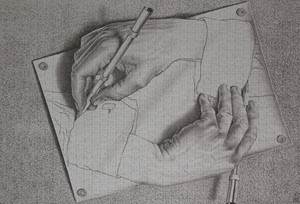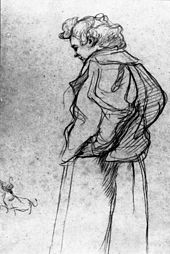Exercise 22. Make up the dialogues of your own on the following situations. Dramatize them. Use phrases from Table 1 (Appendix)
Situation 1
You are a teacher in painting. Discuss with your students the role of artistic elements in painting.
Some of your students don’t share your opinion. Try to change their views.
Situation 2
Your friend is a first-year student of speciality of design. He is interested in different painting media. Explain him the difference between them and explain their main techniques.
Unit II
Drawing
 |
I. Vocabulary
Exercise 1. Read and memorize the following words and word- combinations.
| 1.drawing syn. plan | малюнок, креслення |
| 2. cartooning | карикатура |
| 3. doodling | ескізне уявлення |
| 4. line drawing | малюнок олівцем |
| 5. stippling | малювати (гравірувати) пунктиром |
| 6. shading syn. hatching | штрихування |
| 7. tracing | калькування |
| 8. sketch syn. underdrawing, drawing, outline | ескіз |
| 9. two-dimensional | двовимірний |
| 10. pen and ink syn. stylus, pen | перо |
| 11. crayon syn. pastel | пастель |
| 12. charcoal | деревне вугілля |
| 13. draftsman syn. draughtsman | кресляр, рисувальник |
| 14. cardboard | картон |
| 15. temporary | тимчасовий |
| 16. monochrome | однокольоровий |
| 17. exploratory | дослідницький |
| 18. implement syn. instrument, tool | інструмент |
| 19. intermittent | переривчастий |
| 20. density | щільність |
| 21. translucent | напівпрозорий |
| 22. highlight | світловий ефект |
| 23. rendition | зображення |
| 24. blending stump | змішувальна розтушовка |
| 25. to shrink | зменшувати, скорочувати |
| 26. vanishing point syn. point of convergence | точка сходження |
| 27. to converge | сходитися |
Exercise 2. Find the odd one in each group:
- stylus, pen and ink, monochrome, pen
- underdrawing, doodling, drawing, outline
- implement, instrument, plan, tool
4.crayon, charcoal, pastil, pastel
Exercise 3. Match the words on the left with their meanings on the right:
1. entopic graphomania a) drawing on a translucent paper around the outline
of preexisting shapes shown through the paper
- stippling b)the graded areas of tone, lines, dots indicating light and dark in a painting or drawing
- shading c) a drawing made with lines only
- line drawing d) to draw, engrave, or paint using dots or flecks
5. tracing e)dots made at the sites of impurities in a blank sheet of paper and lines then made between the blank dots
Exercise 4. Find in the text derivatives containing suffixes 1. -tion; -ment; -ist; -ing 2. -ous, -,ual - ic; of the following words, say to what part of speech they belong to and translate them:
- to draw, to mark, to express, to observe, to underdraw, to implement, to shade, art
- vision, universe, continuation, atmosphere
Exercise 5. Give the Ukrainian/Russian equivalents for the following words and word-combinations without using a dictionary:
Form, visual, category, figure, surrealist method, instrument, marker, metal, material, plastic, fundamental, universal, line, tone, terminology, emphasis, effect, control (v), technique, contour, perspective.
II Reading
Exercise 6. Read and translate the text A:
Text A Drawing
 Madame Palmyre with Her Dog, 1897. Henri de Toulouse-Lautrec Madame Palmyre with Her Dog, 1897. Henri de Toulouse-Lautrec |
Drawing is a form of visual expression and is one of the major forms within the visual arts. There are several categories of drawing, including figure drawing, cartooning and doodling. There are also many drawing methods, such as line drawing, stippling, shading, the surrealist method of entopic graphomania and tracing. A quick, unrefined drawing may be called a sketch.
Drawing makes use of any number of drawing instruments to mark a two-dimensional medium. Instruments used include graphite pencils, pen and ink, inked brushes, wax color pencils, crayons, charcoal, chalk, pastels, various kinds of erasers, markers, styluses and various metals. An artist who works in drawing may be called a draftsman or draughtsman.
The most common support for drawing is paper, although other materials, such as cardboard, plastic, leather, canvas, and board may be used. Temporary drawings may be made on a blackboard or whiteboard or almost anything. The medium has been a popular and fundamental means of public expression throughout human history. It is one of the simplest and most efficient means of communicating visual ideas. The easy availability of basic drawing instruments makes drawing more universal than most other media.
Drawing is generally concerned with the marking of lines and areas of tone onto paper. Traditional drawings were monochrome, or at least had little colour, while modern colored-pencil drawings may approach or cross a boundary between drawing and painting. In Western terminology drawing is distinct from painting. Dry media such as chalk may be used in pastel paintings. Drawing may be done with a liquid medium, applied with brushes or pens. Similar supports likewise can serve both: painting generally involves the application of liquid paint onto prepared canvas or panels, but sometimes an underdrawing is drawn first on that same support. Drawing is often exploratory, with considerable emphasis on observation, problem-solving and composition. Drawing is regularly used in preparation for a painting.
Working on an image the artist wants to gain an understanding of how the various media will work. The different drawing implements can be tried on practice sheets in order to determine value and texture, and how to apply the implement in order to produce various effects.
The stroke of the drawing implement can be used to control the appearance of the image. Ink drawings typically use hatching, which consists of groups of parallel lines. Cross-hatching uses hatching in two or more different directions to create a darker tone. Broken hatching, or lines with intermittent breaks, is used to form lighter tones, and by controlling the density of the breaks a graduation of tone can be achieved. Stippling uses dots to produce tone, texture or shade.
Sketch drawings use similar techniques, although with pencils and drawing sticks continuous variations in tone can be achieved. Often the lines in a sketch are drawn to follow the contour of the subject being drawn, thus producing a depth effect.
In fields outside art, technical drawings or plans of buildings, machinery and other things are often called "drawings" even when they have been transferred to another medium by printing.
III. Language
Exercise 7. Find in the text and put down English equivalents to the following word combinations:
Наочна виразність, візуальне мистецтво, невишуканий малюнок, інструменти для малювання, забезпечення для малювання, тимчасові малюнки, фундаментальні засоби суспільного вираження, традиційні малюнки, сухі (рідкі) засоби, аркуші паперу для тренування, малюнки зроблені чорнилом, перехресне штрихування, переривчасте штрихування, технічні ескізи.
Exercise 8. Fill in the blanks with appropriate words:
1. A quick, unrefined drawing may be called a … .
(painting, sketch, seascape)
2. Drawing makes use of any number of drawing instruments to mark a .. medium.
(two-dimensional, three-dimensional, stylus)
3. An artist who works in drawing may be called a …. .
(draftsman, sculptor, painter )
4. The stroke of the drawing … can be used to control the appearance of the image.
(cardboard, tone, implement)
5. … media such as chalk may be used in pastel paintings.
(liquid, dry, various )
Exercise 9. Make up the possible word combinations out of the following and translate them:
| 1. to mark 2. to work on 3. to create 4.to involve 5. to work on 6. to follow 7. to determine 8. to apply 9. to produce 10. to control | a. on an image b. the application of liquid paint c. the contour of the subject d. value and texture e. an image f. the implement g. various effects h. the appearanceof the image i.a darker tone j.a medium |
Exercise 10. Match the definitions to the terms in the left column:
| 1. Ink drawing 2. Cross-hatching 3. Broken hatching 4. Stippling 5. Sketch drawing | a) is used to form lighter tones. b)means thatwith pencils and drawing sticks continuous variations in tone can be achieved. c) uses hatching in two or more different directions to create a darker tone. d) uses dots to produce tone, texture or shade. e) uses hatching, which consists of group of parallel lines. |
IV. Text understanding
